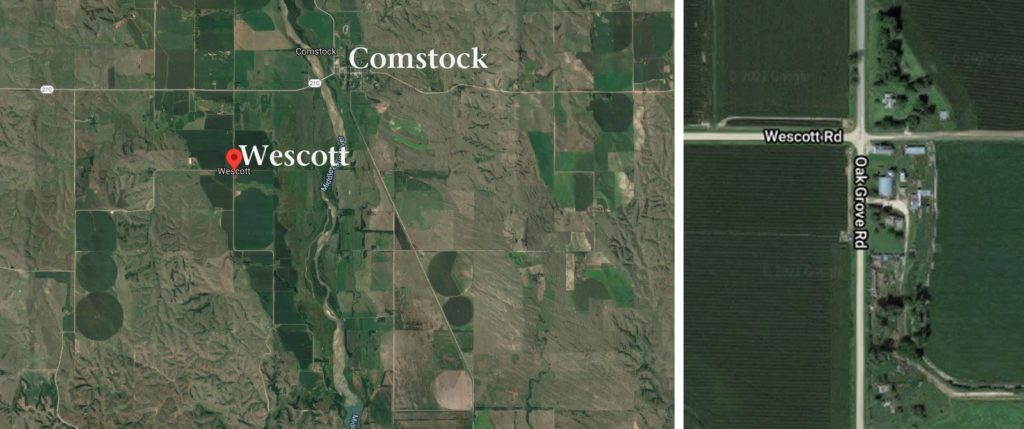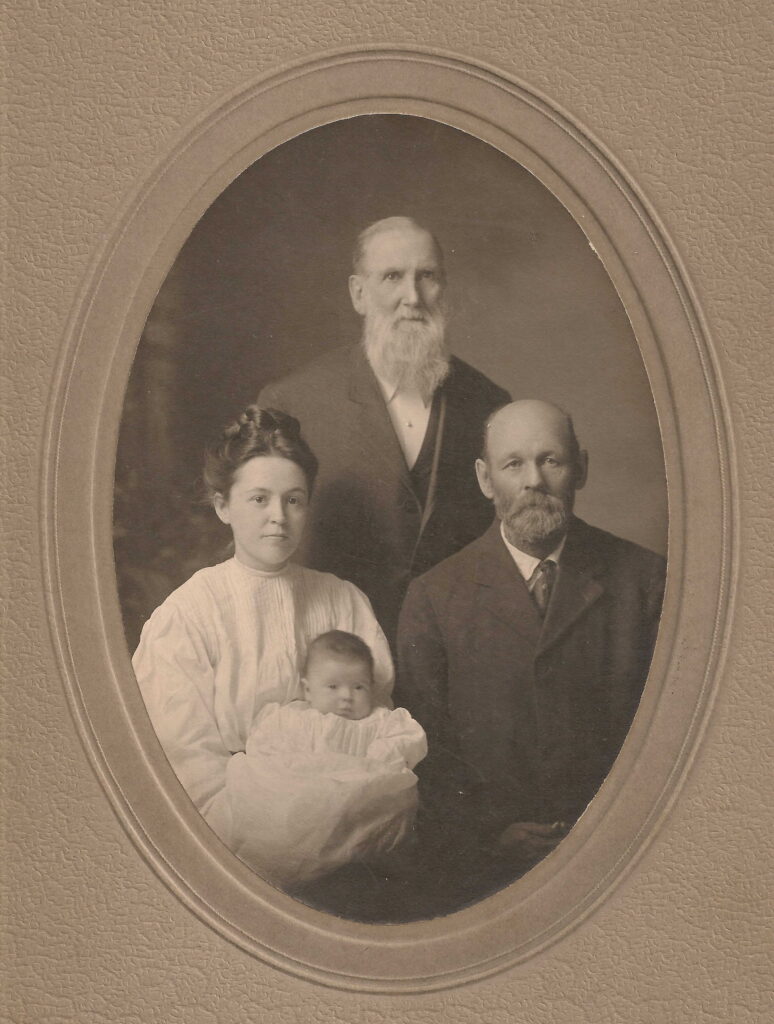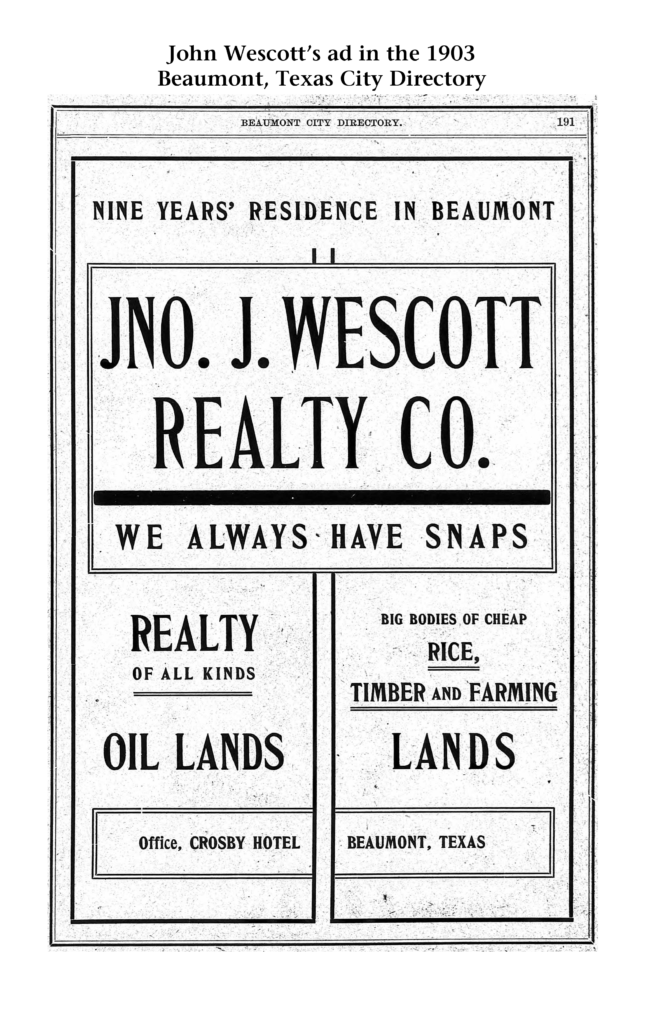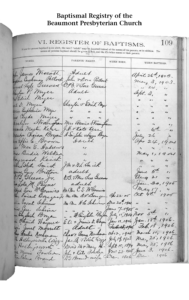Among the items from Westcott (and Wescott) named businesses in the Westcott Society Collection are two letters written in 1904 by John J. Wescott of Beaumont, Texas, first to T.J. Scott of Tampa, Florida and the other to Charles Scott of Montgomery, Alabama, both looking to broker the sale of cypress and other timber from the southeast to eager buyers in Texas. There is nothing unusual about the proposed deal as the river port of Beaumont had been a major lumber town in the 1800s and was experiencing an oil boom as the local timber supply was waning. What is intriguing is that the names listed on the masthead of each letter connect John’s business ventures back to a governor of Nebraska and to a town in the Cornhusker State named Wescott.

Google image shows current-day Wescott is a lightly populated hamlet, but it was a thriving village in 1900.
Wescott, Nebraska is a crossroads in Custer County 2.5 miles southwest and across the Middle Loop River from Comstock, where there is a Wescott Baptist Church. The crossing roads are Wescott Road (E-W) and Oak Grove Road (N-S). Wescott was settled in 1880 by Walter Scott Wescott, John’s father, and Walter’s business partner and son-in-law Edward Gibbons, both of whom are listed on the American Union Oil and Refining Co. letter (second letter) as officers and directors. Walter is a Second Vice President and Treasurer “Beaumont, formerly of Wescott, Neb.”; if he actually located to Beaumont, it was a short stay. Edward Gibbons “of Wescott, Nebraska” is a Director. Before 1880, Wescott and Gibbons were living in Wisconsin, where Walter was a successful businessman and a force in the Republican Party from its nomination of John C. Freemont for President (1856) and then Abraham Lincoln (1860).
Walter Scott Wescott (1828-1908) was a descendant in the eighth generation of Richard Westcott, who emigrated to New England sometime before 1637 and settled in the Connecticut Colony: Walter Scott8 Wescott, John7, Ezra6, Ezra5 Westcott, John4, John3, John2, Richard1. Walter was a cattleman, entrepreneur, politician, and a “pioneer of Custer County.” An obituary in the Arcadia Champion (Arcadia, Nebraska) on Thursday, April 9, 1908 tells the story of Walter Scott Wescott and his eponymous town:
Mr. Wescott continued to reside on his farm near Monroe [Wisconsin] where he was successful, until 1880. In 1880 he established a ranch near Oak Grove [Nebraska], on the Middle Loup river about three miles from Comstock and engaged in the cattle and horse business with his son-in-law Edward Gibbon [sic] from that time until the time of his death, the firm of Wescott and Gibbon [sic] being recognized as the most successful and most progressive cattle and horse men in this part of the state.
In 1886 he removed permanently to Custer county, and established his residence on a ranch about three miles from Comstock. He established the post office of Wescott, built a general store, established a bank and Wescott became a thriving little village. On building of the Burlington road the town of Comstock was established, and Wescott was abandoned.

Three generations of Wescotts: A photo taken some time between 1897 and 1908 shows Walter Scott Wescott, his daughter-in-law May Blakely Wescott holding either Muriel or James, and Walter’s son John James Wescott. This and other images of the family can be found in the gallery of the MacDonald Family Member Tree (Gordon MacDonald) on Ancestry.
Distant cousin John James Wescott was born in Monroe Grove, Wisconsin on August 13, 1864 to Walter Scott and Thankful (Cleveland) Wescott. John married Mary (May) Blakley (1866-1929) of Monroe Grove in 1892; they had two children, Carol Muriel Wescott (1897-1899) and James Blakely Wescott (1905-1965). In about 1894, according to a 1903 city directory ad in which he claims “Nine Year’s Residence in Beaumont,” John moved to Beaumont, Texas, where he dealt in oil lands, timber stands and rice fields.and in the transport of oil and lumber. The rest of the family was up north for the birth of the two children, but Muriel died in Beaumont. We don’t know how successful he was in these ventures, but he returned to Monroe Grove sometime before 1910 and was living with his in-laws. By 1920 he was living in the Washington, D.C area. He died a widower in 1947 in Silver Spring, Maryland.
And the Governor
The stationery for Wescott Oil and Transport Co. (the first letter) lists John as Second Vice President and Treasurer and an E.M. Wescott as Secretary and General Treasurer. (E.M.’s identity has not been resolved; it might even be John’s sister Eda Mary (Wescott) Bragg, but that’s a long shot.) The top of the letter head touts the Honorable E.P. Savage, Governor of Nebraska, as the president of the company. Savage, probably one of Walter’s Republican Party connections, may be more than an honorific appointment to give some gravitas to the enterprise, as Ezra Perrin Savage was in the investment business before and during his political career, and was in the lumber business in the northwest as the end of the decade. The only problem was that Savage had been out of office for more than a year when John wrote the letter, and Savage’s reputation may have been tainted by his predecessor in office and his pardon of a former state treasurer.
Sources:
Ancestry.com MacDonald Family Member Tree (Gordon MacDonald)
Find-A-Grave Walter Scott Wescott memorial
Juneanne Wescoat Glick, Westcote (Clayton, New Jersey: Bregler Associates, 1991), especially pages 415 and 416.
National Governors Association, H.P. Savage profile




